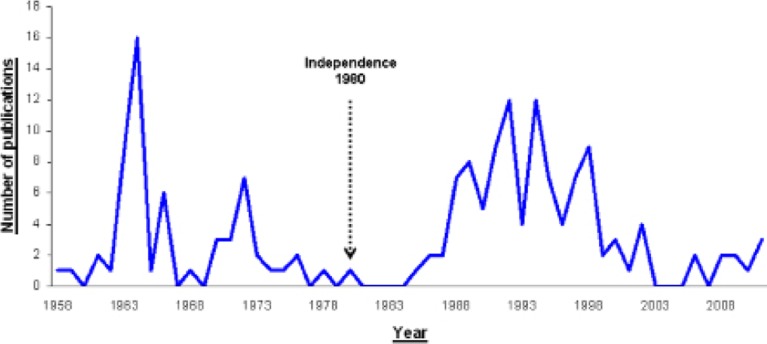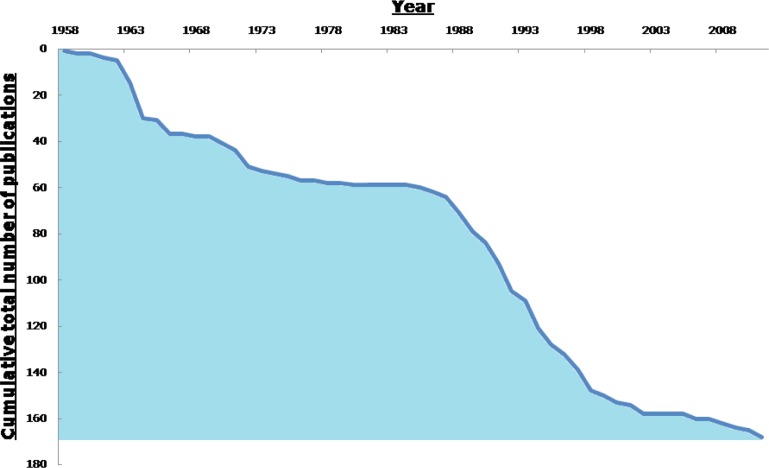Abstract
PubMed and Google Scholar were searched to obtain articles originating from Mpilo Central Hospital, Bulawayo, Zimbabwe - 1958 to August 2011 (54 years). 168 articles cited 999 times were retrieved giving about 6 citations per article. Analysis of publication trends over time as well as publication avenues is made. The full research dataset for this study is shared. This study adds to the body of knowledge on teaching hospital research performance assessment particularly in low-income settings, a topic with few studies. Africa needs data on research.
Introduction
The contribution of Africa, which is generally composed of low- and middle-income countries (LMICs), to global biomedical research is restricted1. Several reasons exist for this scenario including limited scientific writing technical ability, English not being a primary language, minimal or no funding of research by local and national bodies, overwhelming teaching burden, bias from high income country editors, editorial boards, publishers against LMICs researchers, journals, LMICs journals not being indexed in global databases2. Scientific publications play an important role in the scientific process providing a key linkage between knowledge production and use1,3.
Mpilo African Hospital, a teaching hospital, was opened in August 1958 to cater predominantly for the indigenous population4 the designation ‘African’ denoted the prevailing racial notions during the colonial era. Nowadays Mpilo Central Hospital is the largest among public or private hospitals in the city of Bulawayo, Zimbabwe's second city which is located about 440km South West of the capital Harare. The word Mpilo originates from the Ndebele language word for life - Mpilo is a public hospital. The dynamic growth of the hospital and its catchment area has been previously documented elsewhere4,5.
Here, focus is on characterization of the scholarly output from Mpilo Central Hospital as measured by the analysis of articles retrieved by searching PubMed and Google Scholar 6.
Search strategy and selection criteria
PubMed and Google Scholar were searched with the term “Mpilo”. The search included English language articles from the first retrieved article published in 1958 up to the latest article published in August 2011. Use of a personal database of articles was also made. Selection criteria for the articles was that at least one of the authors was affiliated with Mpilo Central Hospital or in the researcher's opinion significant data had been obtained from Mpilo Central Hospital. Number of citations to an article was obtained from Google Scholar.
Results
A total of 168 articles (166 journal articles and a conference abstract and a poster) were identified using the above mentioned search strategy and selection criteria. Article types included letters, case reports/series, and so on but no randomized controlled trials. Various specialties were represented including, internal medicine, peadiatrics, obstetrics and gynaecology, general surgery, urology, neurosurgery, ear nose and throat, radiology, oncology.
A pattern was observed, where two ‘peaks’ in publication occurred, one before Zimbabwe's independence in 1980 and the other peak after independence (Figure 1). The time period around independence was characterized by paucity of publications. 39% of the articles were published in a local (Zimbabwean) journal, the Central African Medical Journal. 54% of the published articles appeared in five of 61 publication avenues (Table 1).
Figure 1.
Number of publications from Mpilo Central Hospital per year from 1958 – August 2011, showing two distinct ‘peaks’ in publication (before and after Zimbabwe's independence.
Table 1.
Top five publications in which articles from Mpilo Central Hospital were published 1958 – August 2011
| Rank | Publication avenue (n = 61) | Number of articles (n = 168) |
Percentage of total articles* |
| 1 | Central African Medical Journal | 65 | 39% |
| 2 | Journal of the Royal College of Surgeons of Edinburgh | 9 | 5% |
| 3 | Archives of Disease in Childhood | 6 | 4% |
| 3 | British Medical Journal | 6 | 4% |
| 5 | Clinical Radiology | 5 | 3% |
| TOTAL | 91 | 54% |
Rounded to the nearest percentage
The 168 articles were cited a total of 999 times giving about 6 citations per article. The most cited paper was a 1997 paediatrics paper “Pulmonary manifestations in HIV seropositivity and malnutrition in Zimbabwe.” by Ikeogu MO and colleagues which was cited 89 times (Table 2). Several articles from Mpilo Central Hospital have been published in top tier journals, for example a recent article in the New England Journal of Medicine7.
Table 2.
Top five cited articles from Mpilo Central Hospital 1955 – August 2011
| Rank | Article title and year published | Number of citations (n = 999) |
Percentage of total citations* |
| 1 | Pulmonary manifestations in HIV seropositivity and malnutrition in Zimbabwe, 1997 [8] |
89 | 9% |
| 2 | Haemolytic-Uraemic Syndrome in Typhoid Fever, 1974 [9] | 68 | 7% |
| 3 | Systemic lupus erythematosus in Zimbabwe, 1986 [10] | 47 | 5% |
| Clinical and Therapeutic Aspects of Kerosene Poisoning: A Series of 200 | |||
| 4 | Cases, 1964 [11] | 37 | 4% |
| 5 | Relationship between bladder cancer incidence, Schistosoma haematobium infection, and geographical region in Zimbabwe. 1990 [12] |
33 | 3% |
| TOTAL | 274 | 27% |
Rounded to the nearest percentage
The full research dataset for this study is shared (Supplementary appendix - available from author), which shows that most of the scholarly output from Mpilo Central Hospital reported little external funding.
Discussion
Consistent with findings by other workers, Mpilo Central Hospital (MCH) like the whole of Zimbabwe experienced a downturn in the number of publications between 1995 and 200413. The waning Zimbabwean economic situation during these years and beyond14 is reflected in the declining number of publications emerging from MCH during this time period to the present day. Similarly, around Zimbabwe's independence in 1980 - a time of significant sociopolitical change - there were few papers published from MCH. These aforementioned publication trends highlight the predictable circumstance that research output is related to the prevailing social, economic and political climate.
Zimbabwe is among the southern African countries at the epicenter of the HIV pandemic, its HIV prevalence in those aged 15–49 years old has been above 10% from 1990 to the time of writing; the HIV prevalence has been declining from a peak of 26.5% in 1997 and that downward trend has continued ever since15. The most cited paper from MCH was in the area of HIV8 showing that important and relevant local research is performed to address local pressing health challenges. Furthermore, about 40% of MCH articles were published in a Zimbabwean journal thereby presumably closely coupling local scientific knowledge production and use.
There are few published studies that specifically assess the institutional research performance of teaching hospitals despite the results of such studies being essential for formulating, reviewing, and improving institutional research policies that strengthen and promote institutional growth16. This study adds to the body of knowledge on teaching hospital research performance assessment, particularly in low-income settings. Africa needs data on research17. Dearth of similar studies makes comparison difficult.
The full research dataset is shared in order for others to make fuller use of the results and also to save them time and effort18. Several medical text books have an author based at MCH; these books were not identified by the search strategy and selection criteria and were hence excluded in the analysis which is a limitation in assessing MCH's scholarly output. A representative text book is cited here19.
Also not revealed by the search technique and not included in the analysis is a series of articles20,21,22. The author of these articles - to a significant extent - used her experiences at MCH to draw conclusions about Zimbabwe's health system.
Conclusion
This study adds to the body of knowledge on teaching hospital research performance assessment particularly in low-income settings, a topic with few studies.
Figure 2.
Cumulative total number of publications from Mpilo Central Hospital per year from 1958 – August 2011. The figure resembles the side view of a mountain, the steeper the gradient the highter the number of publications.
Conflict of interest
GM is an employee of Mpilo Central Hospital.
Funding
None
References
- 1.Uthman OA, Uthman MB. Geography of Africa biomedical publications: an analysis of 1996–2005 PubMed papers. Int J Health Geogr. 2007;10(6):46. doi: 10.1186/1476-072X-6-46. [DOI] [PMC free article] [PubMed] [Google Scholar]
- 2.Muula AS. Medical Journals and Authorship in Low-income Countries. Croat Med J. 2008;49(5):681–683. doi: 10.3325/cmj.2008.5.681. [DOI] [PMC free article] [PubMed] [Google Scholar]
- 3.Uthman OA. Performance, priorities, and future of biomedical research publications in Africa: Need for networks between scientists in developed and developing countries. Pan Afr Med J. 2008;1:5. [PMC free article] [PubMed] [Google Scholar]
- 4.Grave GF. Surgery in Rhodesia. Mpilo Central Hospital, Bulawayo. Ann R Coll Surg Engl. 1972;51(5):332–333. [PMC free article] [PubMed] [Google Scholar]
- 5.Kalangu KK. Pediatric neurosurgery in Africa - present and future. Childs Nerv Syst. 2000;16(10–11):770–775. doi: 10.1007/s003810000343. [DOI] [PubMed] [Google Scholar]
- 6.Bauer K, Bakkalbasi N. An Examination of Citation Counts in a New Scholarly Communication Environment. D-Lib Magazine. 2005;11(9) [Google Scholar]
- 7.Tombe M. Images in Clinical Medicine. Hemoglobinuria with malaria. N Engl J Med. 2008;358(17):1837. doi: 10.1056/NEJMicm070121. [DOI] [PubMed] [Google Scholar]
- 8.Ikeogu MO, Wolf B, Mathe S. Pulmonary manifestations in HIV seropositivity and malnutrition in Zimbabwe. Arch Dis Child. 1997;76(2):124–128. doi: 10.1136/adc.76.2.124. [DOI] [PMC free article] [PubMed] [Google Scholar]
- 9.Baker NM, Mills AE, Rachman I, Thomas JE. Haemolytic-Uraemic Syndrome in Typhoid Fever. Br Med J. 1974;2(5910):84–87. doi: 10.1136/bmj.2.5910.84. [DOI] [PMC free article] [PubMed] [Google Scholar]
- 10.Taylor HG, Stein CM. Systemic lupus erythematosus in Zimbabwe. Ann Rheum Dis. 1986;45(8):645–648. doi: 10.1136/ard.45.8.645. [DOI] [PMC free article] [PubMed] [Google Scholar]
- 11.Baldachin BJ, Melmed RN. Clinical and Therapeutic Aspects of Kerosene Poisoning: A Series of 200 Cases. Br Med J. 1964;2(5400):28–30. [PMC free article] [PubMed] [Google Scholar]
- 12.Thomas JE, Bassett MT, Sigola LB, Taylor P. Relationship between bladder cancer incidence, Schistosoma haematobium infection, and geographical region in Zimbabwe. Trans R Soc Trop Med Hyg. 1990;84(4):551–553. doi: 10.1016/0035-9203(90)90036-e. [DOI] [PubMed] [Google Scholar]
- 13.Hofman K, Kanyengo C, Rapp B, Kotzin S. Mapping the health research landscape in Sub-Saharan Africa: a study of trends in biomedical publications. J Med Libr Assoc. 2009;97(1):41–44. doi: 10.3163/1536-5050.97.1.007. [DOI] [PMC free article] [PubMed] [Google Scholar]
- 14.World Bank, World Development Indicators, author. Zimbabwe Gross Domestic Product. Google public data explorer beta. [27/11/2011]. Available http://www.google.com/publicdata/directory.
- 15.World Bank, World Development Indicators, author. Prevalence of HIV, total (% of population ages 15–49) Google public data explorer beta. [27/11/2011]. Available http://www.google.com/publicdata/directory.
- 16.Tess BH, Furuie SS, Castro RC, Baretto Mdo C, Nobre MR. Assessing the scientific research productivity of a Brazilian healthcare institution: a case study at the Heart Institute of São Paulo, Brazil. Clinics (Sao Paulo) 2009;64(6):571–576. doi: 10.1590/S1807-59322009000600013. [DOI] [PMC free article] [PubMed] [Google Scholar]
- 17.Ijsselmuiden C, Marais DL, Becerra-Posada F, Ghannem H. Africa's neglected area of human resources for health research - the way forward. S Afr Med J. 2012;102(4):236–241. [PubMed] [Google Scholar]
- 18.Pisani E, Whitworth J, Zaba B, Abou-Zahr C. Time for fair trade in research data. Lancet. 2010;375(9716):703–705. doi: 10.1016/S0140-6736(09)61486-0. [DOI] [PubMed] [Google Scholar]
- 19.Ngwenya S, Lindow S. Part 2 MRCOG revision made easy. PasTest. 2007 [Google Scholar]
- 20.Adams K. Zimbabwe: an eyewitness account. BMJ. 2008:336. doi: 10.1136/bmj.39450.635579.0F. [DOI] [Google Scholar]
- 21.Adams K. Zimbabwe's health system is now in a state of collapse. BMJ. 2008:337. doi: 10.1136/bmj.a2637. [DOI] [Google Scholar]
- 22.Adams K. Zimbabwe's health system is beginning to function again. BMJ. 2010:341. doi: 10.1136/bmj.c4211. [DOI] [Google Scholar]




